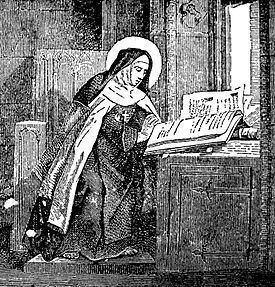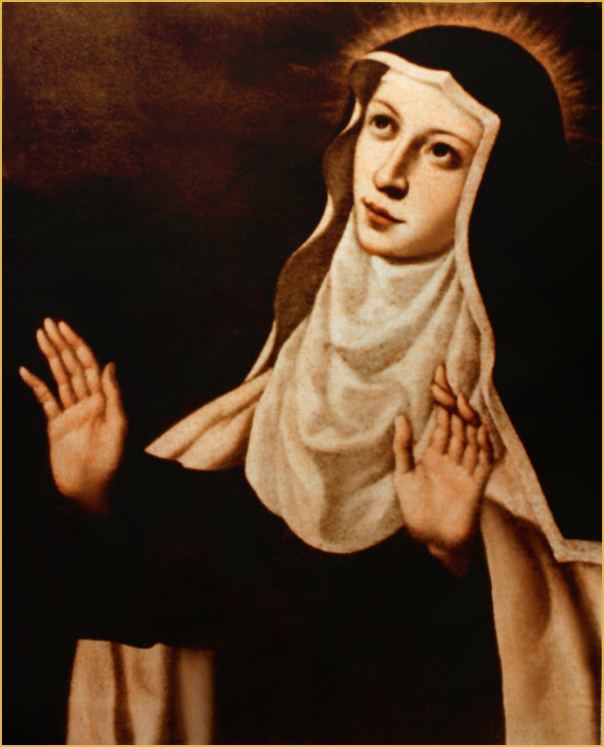Beatified 1626 | Name Mary de' | |
 | ||
Feast May 25 (May 29 from 1728-1969) Patronage against bodily ills; against sexual temptation; against sickness; sick people; Naples (co-patron) Books Maria Maddalena De' Pazzi: Selected Revelations Similar People Simon Stock, Teresa Margaret of the Sacre, Pietro Novelli, Kuriakose Elias Chavara, Teresa of Avila | ||
St mary magdalene de pazzi
Mary Magdalene de' Pazzi, O.Carm. (Italian: Maria Maddalena de' Pazzi; April 2, 1566 – May 25, 1607) was an Italian Carmelite nun and mystic. She has been declared a saint by the Roman Catholic Church.
Contents
- St mary magdalene de pazzi
- Saint mary magdalene de pazzi
- Life
- Mystic
- Veneration
- Feast day
- Critical reception
- References

Saint mary magdalene de pazzi
Life
Pazzi was born at Florence, Italy, on April 2, 1566, to Camillo di Geri de' Pazzi, a member of one of the wealthiest and most distinguished noble families of Renaissance Florence, and Maria Buondelmonti. She was christened Caterina, but in the family was called Lucrezia, out of respect for her paternal grandmother, Lucrezia Mannucci. Even as a girl Caterina was attracted to prayer, solitude, and penance.
At the age of nine Pazzi was taught how to meditate by the family chaplain, using a recently published work explaining how one should meditate on the Passion of Christ. Years later, this book was one of the items she brought with her to the monastery. She made her First Communion at the then-early age of 10 and made a vow of virginity one month later. She experienced her first ecstasy when she was only twelve, in her mother's presence. From then on, she continued to exhibit many varied mystical experiences.
In 1580, at age fourteen, Pazzi was sent by her father to be educated at a monastery of nuns of the Order of Malta, but she was soon recalled to wed a young nobleman. Caterina advised her father of her vow, and he eventually relented and allowed her to enter monastic life. She chose the Carmelite Monastery of St. Mary of the Angels in Florence because the rule there allowed her to receive Holy Communion daily. In 1583 she was accepted as a novice by that community, and given the religious name of Sister Mary Magdalene.
Mystic
Pazzi had been a novice for a year when she became critically ill. Upon receiving the religious habit, her heart was filled with an ardent desire to suffer for Jesus. One of the sisters asked her how she could bear so much pain without a murmur. Mary pointed to the crucifix and said:
Death seemed near, so her superiors let her make her profession of religious vows in a private ceremony, while laying in a cot in the chapel. Immediately after, she fell into an ecstasy that lasted about two hours. This was repeated on the following 40 mornings, each time after Communion.
As a safeguard against deception and to preserve the revelations, Pazzi confessor asked her to dictate her experiences to her fellow nuns. Over the next six years, five large volumes were filled. The first three record ecstasies from May 1584 through Pentecost week of the following year. That particular week was a preparation for a severe five-year trial. The fourth book records that trial and the fifth is a collection of letters concerning reform and renewal. Another book, Admonitions, is a collection of her sayings arising from her experiences in the formation of women in religious orders.
Through much of her life, Pazzi continued to be prone to raptures and profound ecstasies, but she also experienced a period of great temptation and of spiritual dryness that lasted for over five years, without losing faith and hope in God, ending only on Pentecost Sunday, 1590. A famous incident was her ringing the bells of the monastery one night to announce to the puzzled nuns that Love was Itself not loved. While her mystical experiences sometimes caused dramatic, even eccentric, behavior she was never narcissistic or self-preoccupied. She even rejoiced if her prayers were not granted because it meant that God's will was being done, not hers.
It was said that Pazzi could read the thoughts of others and predict future events. For instance, during one ecstatic event she predicted the future elevation to the papacy of Cardinal Alessandro de' Medici (as Pope Leo XI). During her lifetime, she appeared to several persons in distant places and cured a number of sick people. She was able, even while in ecstasy, to perform the routine duties of the monastery conscientiously and well. She served terms as mistress of the junior professed, mistress of novices and sub-prioress. She also, and this is perhaps the most important part of her relevancy, had a deep longing for the reform of the Church and the conversion of the world.
Pazzi died relatively young—even for her era—on Friday, May 25, 1607, at the age of 41. She was buried in the choir of the monastery chapel. When the nuns moved from the site, they took the saint’s body with them. Today it rests in a glass casket in the Monastery of Santa Maria Maddalena de' Pazzi in Careggi, in the hills to the north of her native city. To say that her body is incorrupt would be something of an overstatement. Nevertheless, her body was declared miraculously incorrupt at her canonization in 1668.
Veneration
Numerous miracles allegedly followed Pazzi's death, and the process for her beatification was begun in the year 1610 under Pope Paul V, and completed under Pope Urban VIII in the year 1626. She was not, however, canonized until 62 years after her death, when Pope Clement IX raised her to the altars on April 28, 1669. The church of the Monastery of Pažaislis, commissioned in 1662 in Lithuania, was one of the first to be consecrated in her honor.
The saint herself is little known outside Italy, but her cult is very strong, especially in Florence. Paulist Press issued a selection of her writings in English translation in their series of Classics of Western Spirituality.
Feast day
In 1670, the year after Pazzi's canonization, the feast day of the saint was inserted in the General Roman Calendar for celebration on May 25, the day of her death. In 1728, the date of May 25 was assigned instead to Pope Gregory VII, and her feast day was moved to May 29, where it remained until 1969, when it was restored to its original place in the calendar, as the true anniversary of her death.
Critical reception
Pazzi was known to have worn little clothing and having whipped herself with a crown of thorns. According to researcher Ian Wilson sometimes she would wear only a single garment but she would tear this off "in order to roll herself on thorns, or give herself another savage beating." Wilson described Pazzi as a "florid, sadomasochistic neurotic."
Asti Hustvedt has written that "Pazzi wore a crown of thorns and a corset onto which she had attached piercing nails. She also walked barefoot through the snow, dripped hot wax onto her body, and licked the wounds of the diseased, including those afflicted with leprosy."
The anthropologist Eric Dingwall wrote a chapter on Pazzi's masochism and flagellant behaviors in his book Very Peculiar People (1962).
Psychiatrist Armando Favazza in his book Bodies Under Siege (3rd edition, 2011) has written:
At about age 37, emaciated and racked with coughing and pain, she took to her bed until she died four years later. Her painful gums were so badly infected that her teeth fell out, one by one. Her body was covered with putrefying bed sores, but when the sisters offered to move her she warned them off for fear that by touching her body they might experience sexual desires... A large statue of her holding a flagellant whip can be seen in her church in Florence, where people around the world still come to pay her tribute.
According to authors Sasha Alyson and Joe Chapple, 1585 was one of the "earliest recorded cases of masochism, Sister Mary Magdalene de Pazzi begs other nuns to tie her up and hurl hot wax at her." Pazzi is said to have found pleasure in being publicly whipped.
Psychiatrist Kathryn J. Zerbe has written that Pazzi was a sufferer of Anorexia mirabilis. She also displayed behavioral symptoms of bulimia.
